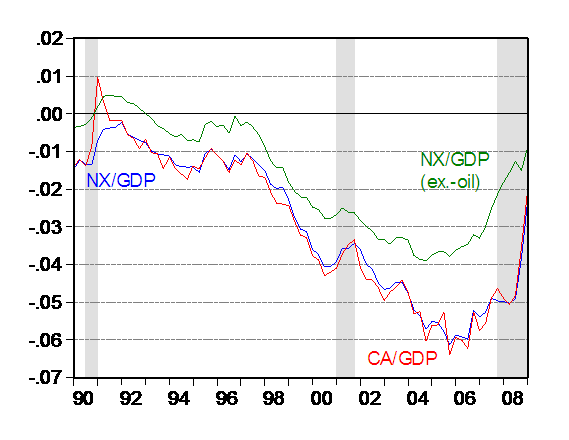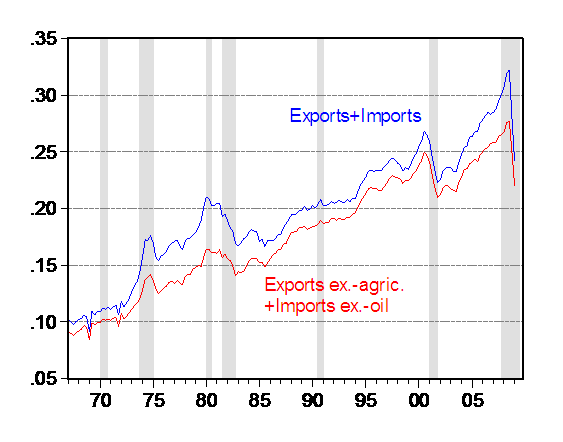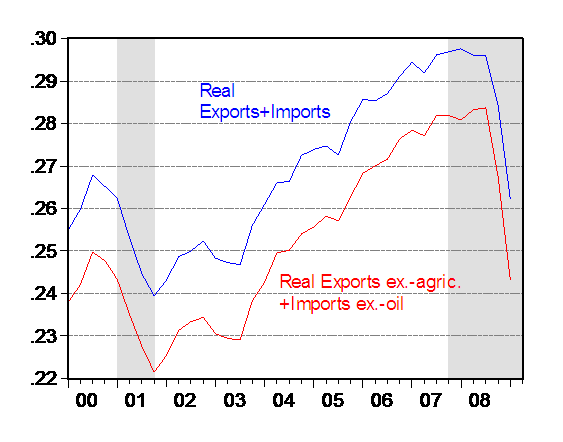It’s not news that the US current account, trade balance and trade balance ex.-oil are all moving toward zero percentage points of GDP. As I’ve observed before, time will tell how much of this movement is durable (see Bertaut, Kamin and Thomas for skeptical look; see also Cline-Williamson); this in turn depends on whether the adjustment reflects standard macro effects, including a permanent downshift in US consumption growth [0], and how much reflects perhaps transitory effects like a credit crunch in trade financing (as speculated upon here). Here’s the trade balance situation for the US.

Figure 1: Net exports to GDP (blue), net exports ex.-oil to GDP (green), and current account to GDP (green). NBER defined recession dates shaded gray; assumes current recession has not ended by 2009Q1. Source: BEA, 2009Q1 GDP preliminary release (28 May 2009), NBER, and author’s calculations.
The trade balance — the difference between exports and imports — obscures the overall trend in both inflows and outflows of goods. What’s of interest is whether the process of deglobalization, first discussed in this post from two and a half years ago (updated here), continues. At that time, oil prices seemed to be critical. Now, it seems that financial issues are at play. Here’s one de facto measure of trade openness, the sum of exports and imports normalized by GDP (as well as exports-ex. agriculture plus imports ex.-oil).

Figure 2: Sum of exports and imports divided by GDP (blue), sum of exports ex.-agricultural goods and imports ex.-oil divided by GDP (red). NBER defined recession dates shaded gray; assumes current recession has not ended by 2009Q1. Source: BEA, 2009Q1 GDP preliminary release (28 May 2009), NBER, and author’s calculations.
What’s clear is nominal trade flows drop during recessions, and tend to resume growth later in recoveries. These shares though incorporate both price and volume changes, so Figure 2 is not a clean measure of trade openness. An alternative is to use “real” measures. Figure 3 presents real trade normalized by real GDP over a shorter period.

Figure 3: Sum of real exports and real imports divided by real GDP (blue), sum of real exports ex.-agricultural goods and real imports ex.-oil divided by real GDP (red). Real series in Ch.2000$. NBER defined recession dates shaded gray; assumes current recession has not ended by 2009Q1. Source: BEA, 2009Q1 GDP preliminary release (28 May 2009), NBER, and author’s calculations.
I will observe that it is not quite kosher to add and divide Chain weighed series. However, a similar pattern is observed if one uses geometric averages instead of arithmetic averages [1].
Using real values tends to shave off the top of the peak ratios in 2008, but the basic fact remains that trade openness has dropped off precipitously.
So, the critical questions for determining future directions in trade openness include:
- Will the supply of trade financing become normalized?
- Will oil prices trend upwards again? And will this cost induce increases in shipping costs, even as oversupply of shipping services tend to depress them?
- Will US consumption continue to stagnate? (See this brief article by Glick and Lansing).
- Will protectionist measures (such as Buy American provisions) be expanded?
Persistent.
One question I don’t see addressed much is the extent to which the overall increase in global trade (which is what you have written about here, but have obscured with the nasty “globalization” label) was driven by international imbalances. China’s growth as a participant in global trade accounts for a lot, and that growth seems to have relied substantially on the large US trade deficit. Much of China’s regional trade was in materials and components that went into finished goods going to the US, so more than just the growth in bilateral trade with the US is accounted for by the US/China imbalance.
If the US is going to pay for its sins now, what implications would that have for the growth in global trade? Same question for international labor mobility. If the US is going to have to earn its own way, will that mean more or less cross-border labor movement?
Do not forget to look at the other side of the equation, the savings – investment flows.
Maybe one of the most under-reported and under-appreciated side effect of the “Great Recession” is that it is generating a massive reduction in US dependence on foreign capital. This is the flip side of the increase in personal savings — weaker consumption — and sharp fall in housing as a share of the economy and credit demands.
As with trade, how much of this is cyclical, and how much is secular is open to debate.
Also open to debate is the question of direction of the causal flow– does less trade generate smaller capital flows, or does reduce capital flows generate less trade?
Menzi– I believe that the great rise in international trade (globalization) was financed by a combination of petrodollar recycling, derivative trading and its attendant securitization and carry-trading. With the advent if the credit crunch and incipient banking and securities regulation, liquidity will drain out of the international financing system faster than “quantitative easing” can put it back. “Normalization” of trade financing will likely have to wait until the mortgage securities problem is purged from the American and European banking systems (2013?). I would expect that oil prices will start to spike again at the same time. US consumer consumption will continue to stagnate as the baby boomers move demographically into retirement and wages freeze due to recession. Protectionism will gain political traction as unemployment mounts. Results from European elections in Holland, Denmark, Italy, Germany and Hungary show that xenophobia is on the rise.
kharris– The US can only pay for its sins by radically reducing its oil imports and reducing China manufactured good imports. That can be done in the short-term by Federal mandates, or in the long term by a radical dollar index decline attended by high interest rates. My guess is that America has been and will continue to go for the long term solution. Mandating passports at all border entries is our current shot at less cross border labor movement.
spencer– Increased personal savings reflects the loss of confidence of consumers with the US securities market. Savings have exited the securities market and entered the CD and money markets. Reduction in consumer credit is prompting savings for discretionary spending.
The connection is between Trade and Liquidity not Trade and Capital Flow. Liquidity comes first!
To the extent that capital goods and consumer durables are over-represented in trade flows (I confess I’m not checking the data on this assertion), the decline in trade partly would reflect the change in the composition of demand during a recession, which should largely reverse when the recovery occurs. That is, we’re just postponing the flat screen TV and BMW purchases, and our trading partners are temporarily holding off on the new caterpillar tractors and Boeing planes.
Whether the unwinding of “global imbalances” is a permanent or not is a different question… One reason to be hopeful is that policy makers may learn that being overly-dependent on exports is almost as perilous as being dependent on capital inflows. The policies that led to the “savings glut” in the wake of the Asian crisis may look like they went too far, and perhaps now will be (partly) reversed.
So, I’d expect trade volumes to recover, but hopefully trade imbalances don’t come back with them.
Professor, quick question: why does it make a difference whether you use real or nominal quantities? I mean, when you take the ratio of nominal quantities doesn’t the price level cancel so what you’re left with is the ratio of the real ones…?
Menzie,
I would to see you repost this in 3-5 years and explain why the go-to-zero trade deficit thinking didn’t work out.
Absent major changes in U.S. trade policy and a massive devaluation of the U.S. Dollar, the U.S. trade balance deficit will not go away as the U.S. exits the recession.
A careful study of U.S. imports vs. U.S. exports is in order. It’s my judgment that you haven’t performed that detailed analysis. The breakdown by category and code is self-explanatory.
For your main post to have any serious merit, the U.S. Dollar will have to implode. And oil exporters will have to abandon the U.S. Dollar as the medium of exchange for crude oil purchases.
As I said, put this post back up in 3-5 years and try explaining why the U.S. trade deficit didn’t remain small or stay in the zero range.
I dare you to repost it in 3-5 years. Seriously…
“I dare you to repost it in 3-5 years. Seriously… ”
You didn’t even read what he wrote, and added in your own wild extrapolations on which you are now attacking him. I’d like to see _your_ narrow insistences reposted in 3-5 years. Seriously …
PM,
Save your childish rant. I read all of Menzie’s posts. And I study trade data all the time.
Try reading the U.S. trade news from today. That line of thinking isn’t holding up right now.
http://www.bloomberg.com/apps/news?pid=20601087&sid=a_15TjtHqhwM
The Commerce trade report is also released today.
In 3-5 years, absent changes in U.S. trade policy and an implosion in the value of the U.S. Dollar, the U.S. trade deficit will once again be unsustainable. This isn’t complicated.
No Movie Guy, there are several ways the US trade deficit can be corrected without more dollar devaluation. The entire purpose of the original post is that higher savings and reduce consumption will reduce imports sharply. I agree with PM, read what he wrote.
Marks — if the recent rise in savings reflect a lack of confidence in markets why is the stock market up some 30% at the same time?
Movie Guy: Please see the first hyperlink, to the Bertaut et al. paper. It makes exactly the point you are making. Indeed, you do not seem to have read the post carefully. In addition, I refer you to my paper “Doomed to Deficits?” for empirical estimates of trade elasticities by subcategories; additional estimates I have cited in previous posts include works by C. Mann. I have a number of other papers which pertain to trade elasticities on my research webpage.
GK: It matters whether you use nominal vs. real because nominal magnitudes include price effects. In principle, real magnitudes would abstract from price changes.
Spencer,
You are dreaming. If you bothered to carefully read the breakdown on U.S. imports and exports, you would be hard pressed to build a case whereby U.S. imports will roll under U.S. exports. U.S. consumption isn’t going to vanish or drop that significantly. Crude oil will shoot back up if you read any of the industry reports, some of which require pricy subscriptions.
I read the papers that Menzie cited. I also read his last post on this subject and believe that he is not going to like what he sees in 3-5 years.
This is an academic exercise, not a reflection of what is likely to happen once consumer demand for normal goods picks back up. Guys like you can toy with this, but it will not stick.
Menzie’s post was lifted by another major econ blog (N.R.). It’s pretty clear what is going to happen with some economists’ thinking. But the data isn’t going to support it. Stay tuned.
By the way, you post on another blog, but typically fail to ever respond to readers comments under your main posts. Get it together.
The U.S. is highly unlikely to change U.S. trade policy. The U.S. needs buyers of its growing federal debt. Very little is going to change on the U.S. trade front.
I know that Menzie cited opposing viewpoints. I can also see where he is heading with his different posts. I’ve run this by some other economists.
The U.S. trade balance will once again become unsustainable. Give it 3-5 years and see what you say then, Spencer.
I think there is a sea change underway. Oil is in it’s last 20 years as the driving force of American foreign policy. Oil imports will continue to decline and the dollar is going to continue to weaken. This cycle causes more conservation by the largest user of oil in the world and contributes to the “new energy economy”. While I rarely agree with Menzie, I do not doubt that American manufacturing and exports are going to rise over the next 3 – 5 years and the U.S. will have not a zero, but a positive trade balance in the years to come.
From the beginning of 2007 until the end of the third quarter of 2008, the U.S. increased its goods exports each quarter (compared with a year earlier) by more than 50 billion dollars.The gain in exports over the previous year was 279 billion in 2007 and the same number (279 billion) in the first three months of 2008 (Table 1.1.6 – Real, not nominal numbers).
The decline in the trade deficit in 2007 was due to exports growing faster than imports. By the first quarter of 2008, goods imports were smaller that in the previous year. In my mind, the U.S. did not begin to withdraw from international trade until the beginning of 2008.
The last 6 months of reported data (ending March, 2009), shows both exports and imports declining (deglobalization from both fronts). Because the imports decline was larger than the export decline, the trade deficit remained at a low level.
My measure of the size of the goods trade deficit is goods trade deficit divided by goods imports. That measure abstracts from GDP, hence more understandable trend. Using that measure, the U.S. trade deficit peaked in 2005 at 46% of goods imports. Subsequent levels were 44%(2006), 40% (2007), 34% (Quarters 1 through 3 of 2008) and 34% (last 6 months).
I belive the goods trade deficit peaked in the U.S. in 2005 because the decline in the value of the dollar since 2002 finally created export opportunities and reduced imports. It is also possible that the crowding out of U.S. production by cheap goods made in China reached a limit as the market for cheap goods in the U.S. is limited.
If the value of the dollar is responsible, that argues that the effect is termporary. Dollar value strongly influenes the trade deficit in the short run but not in the long run. The U.S.goods trade deficit has grown from just over 10% to a peak of 46% in the 25 years from 1980 to 2005 but the real value of the dollar in 2005 is around 100 compared with 89 in 1980. Not enough difference to account for the growth in the trade deficit.
I think the 34% size of the trade deficit is temporary and that it will inflate again when the U.S. economy improves.
If U.S. citizens want a lower goods trade deficit in the future that is not due to an economic collapse or a declining value of the dollar, they should pass legislation aimed at controlling imports to a level close to the size of our exports.